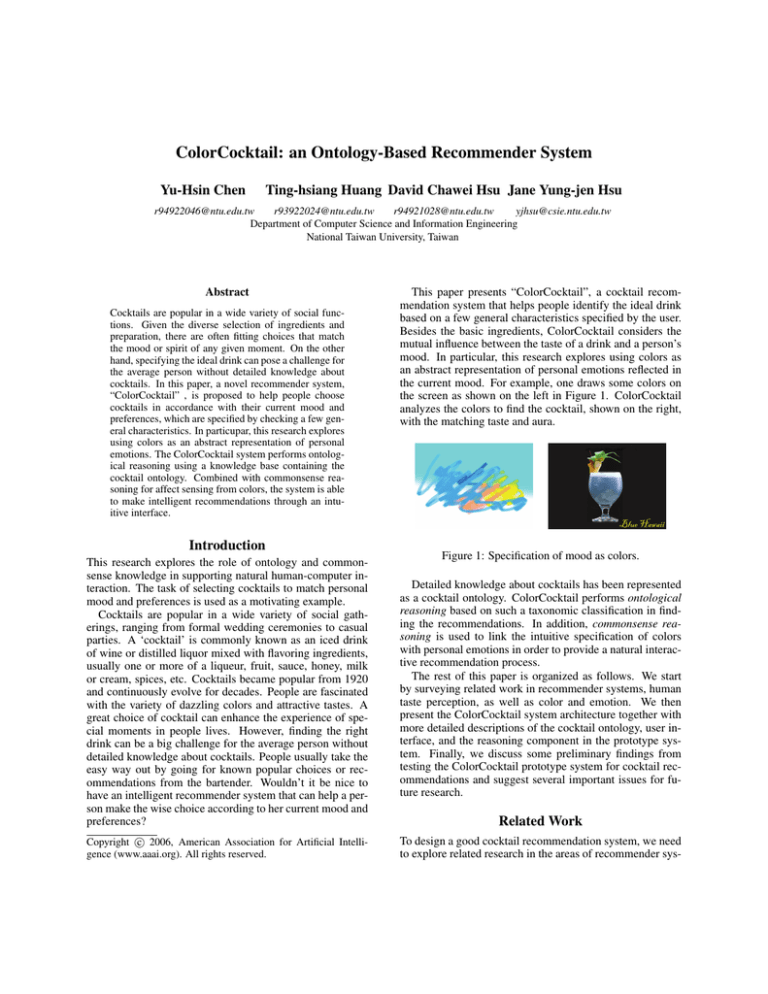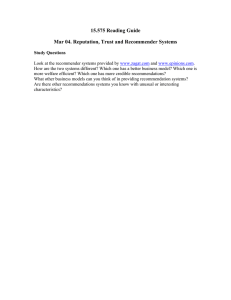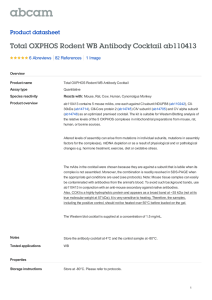
ColorCocktail: an Ontology-Based Recommender System
Yu-Hsin Chen
Ting-hsiang Huang David Chawei Hsu Jane Yung-jen Hsu
r94922046@ntu.edu.tw
r93922024@ntu.edu.tw
r94921028@ntu.edu.tw
yjhsu@csie.ntu.edu.tw
Department of Computer Science and Information Engineering
National Taiwan University, Taiwan
Abstract
Cocktails are popular in a wide variety of social functions. Given the diverse selection of ingredients and
preparation, there are often fitting choices that match
the mood or spirit of any given moment. On the other
hand, specifying the ideal drink can pose a challenge for
the average person without detailed knowledge about
cocktails. In this paper, a novel recommender system,
“ColorCocktail” , is proposed to help people choose
cocktails in accordance with their current mood and
preferences, which are specified by checking a few general characteristics. In particupar, this research explores
using colors as an abstract representation of personal
emotions. The ColorCocktail system performs ontological reasoning using a knowledge base containing the
cocktail ontology. Combined with commonsense reasoning for affect sensing from colors, the system is able
to make intelligent recommendations through an intuitive interface.
Introduction
This paper presents “ColorCocktail”, a cocktail recommendation system that helps people identify the ideal drink
based on a few general characteristics specified by the user.
Besides the basic ingredients, ColorCocktail considers the
mutual influence between the taste of a drink and a person’s
mood. In particular, this research explores using colors as
an abstract representation of personal emotions reflected in
the current mood. For example, one draws some colors on
the screen as shown on the left in Figure 1. ColorCocktail
analyzes the colors to find the cocktail, shown on the right,
with the matching taste and aura.
Figure 1: Specification of mood as colors.
This research explores the role of ontology and commonsense knowledge in supporting natural human-computer interaction. The task of selecting cocktails to match personal
mood and preferences is used as a motivating example.
Cocktails are popular in a wide variety of social gatherings, ranging from formal wedding ceremonies to casual
parties. A ‘cocktail’ is commonly known as an iced drink
of wine or distilled liquor mixed with flavoring ingredients,
usually one or more of a liqueur, fruit, sauce, honey, milk
or cream, spices, etc. Cocktails became popular from 1920
and continuously evolve for decades. People are fascinated
with the variety of dazzling colors and attractive tastes. A
great choice of cocktail can enhance the experience of special moments in people lives. However, finding the right
drink can be a big challenge for the average person without
detailed knowledge about cocktails. People usually take the
easy way out by going for known popular choices or recommendations from the bartender. Wouldn’t it be nice to
have an intelligent recommender system that can help a person make the wise choice according to her current mood and
preferences?
Detailed knowledge about cocktails has been represented
as a cocktail ontology. ColorCocktail performs ontological
reasoning based on such a taxonomic classification in finding the recommendations. In addition, commonsense reasoning is used to link the intuitive specification of colors
with personal emotions in order to provide a natural interactive recommendation process.
The rest of this paper is organized as follows. We start
by surveying related work in recommender systems, human
taste perception, as well as color and emotion. We then
present the ColorCocktail system architecture together with
more detailed descriptions of the cocktail ontology, user interface, and the reasoning component in the prototype system. Finally, we discuss some preliminary findings from
testing the ColorCocktail prototype system for cocktail recommendations and suggest several important issues for future research.
c 2006, American Association for Artificial IntelliCopyright gence (www.aaai.org). All rights reserved.
To design a good cocktail recommendation system, we need
to explore related research in the areas of recommender sys-
Related Work
tems, human perception, especially taste and flavor. In addition, the study of colors and their relationship with emotions.
Recommender System
Recommender systems are popular in nowadays. When you
are surfing the online bookstore Amazon.com, the bookstore
will give you some popular books recently and some book
you may interested in. The ”new” books are shown around
your current view. Another example often occurs in the supermarket. Because you have the member of the super market, every time before paying up, you show your card to the
cashier and the system records the goods you bought. Next
time when you go shopping, it will provide a personal shopping list with special discount for you.
These kind of recommender systems are base on the historical data and the product rating. The system analyzes
what the user bought before, what they viewed before, and
how they rated the products. The most common method
is collaboration filtering. After the analysis, collaboration
filtering recommender system differentiates from one user
profile to another to determine what to recommend. This approach will suffer from the problem of data sparseness and
the first rate problem.
Another way to build a recommender system is contentbased. By comparing the representation of content contained in an item, the content-based method provide recommendations for users. This kind of recommendation need
more effort on extract the content of items. Users of the system do not need to give great feed back. In the meanwhile,
fewer interaction between the system and the user.(Melville,
Mooney, & Nagarajan 2002)
the recommender system better. There exists many models about human emotion in psychology. The PAD emotion
model is one of them. The generality of the PAD emotion
model has three dimensions: pleasure, arousal, and dominance. Kinds of emotion states can be classify into different
categories.
In the work done by Patricia Valdez and Albert Mehrabian (Valdez & Mehrabian 1994), they try to find out the
relationship between color and emotion. This is what we
want to add to our system. Though, color just can partially
represent the mood state of human, we use color to stand for
the mood state to approach the problem.
System Architecture
Be a recommending system, this cocktail recommender’s architecture is similar to other recommending system. It has
user choice and cocktail’s ontology as inputs, some recommending cocktails as output, and DL reasoner as its information inference engine. (Please see Figure 2) Commonsense
reasoning is the future work in our system.
Taste and Flavor
Taste is another important issue in our work. In the basic
wine tasting procedure, tasting, bouquet and color are important features. We try to import the knowledge of wine
into the system.
From the view of physiology, taste buds on the tongue
let human beings have the gustatory perception. There are
around ten thousand taste buds in human’s mouth. Most
of the taste buds are on and around the tiny bumps on the
tongue. They look like little red dots, or raised bumps. Every
taste bud detects five primary tastes including sour, sweet,
bitter, salty and umami(salts from certain acid). Via these
little sensors, human can sense the taste of the food.
In addition to taste, human perception also includes olfaction, vision, etc. If you get a running nose, you lose your
olfaction temporary. Everything you eat will be pretty bland
though your gustation still work. Furthermore, color of the
foods is the first impression for the people. In the procedure
of wine evaluation, color is also the first impression too. In
many commercial Web site, the properties are already available. 1
Color and Emotion
Mood and emotion are considered in the system. We are
trying to add more human factors to the system and make
1
http://www.wines.com/index.html
Figure 2: Architecture
The Cocktail Ontology
To be a good cocktail recommender. The first thing we need
to have is the knowledge about cocktail. Cocktail is any
of various alcoholic beverages consisting usually of brandy,
whiskey, vodka, or gin combined with fruit juices or other
liquors and often served chilled.2
For getting the characteristic of the cocktails, we classify cocktails and build up the ontology. For example,“Blue
Hawaii”, which has a formal name and standard instructions
to make, consists of light rum, pineapple juice, and curacao. So it can be classified to the class of Named-Cocktail.
Named-Cocktail inherits from class Cocktail with the base
wine properties. Furthermore, color and taste are the characteristics of cocktail. So “Blue Hawaii” is a named cocktail
based on light rum with a flavor of light sweet and little sour.
Besides colors, flavors and base wine, glass shape and
alcohol volume are important issue of cocktail. Different
shapes of glasses make different impressions on human beings. This is the reason why we use glass shape to classify
cocktails. Alcohol volume is due to the ingredients of cocktail. It is reflected by mouth feel.
2
http://www.drinksmixer.com/guide/2-1.php
To construct the ontology of cocktail, we refer to some
popular commercial Web site such as www.wines.com to
get some basic classification. And we use Protege to construct the ontology (Gennari et al. 2003). A snapshot of the
cocktail ontology is show in Figure 3.
symbolic meaning (Kopec 2004). So the input of color can
reflect the emotions of human. And we will use this to help
the recommendation.
From the user inputs to the recommended results, we have
shown the inputs, ontology, and the reasoner. Now, it is time
to give you the drinks.
Figure 3: A Part of the Ontology
User Interface
The inputs are including base wine, flavor, glass shape, alcohol volume and the scene(aura). We give seven base
wines, which are beer, brandy, gin, rum, tequila, vodka, and
whiskey. These are the most common wines using in the
cocktail. Users can choose the wine which they have at that
comment; users can also choose the one they want to have
a try. Flavor depends on individual. It reflects the personal
preference and mood. Girls may like a beverage with sweet
and sour, but boys may not like sour very much. A man
to be crossed in love is heartbroken, and therefore wants a
glass of bitter cocktail to reflect his sadness. The choice of
glass shapes is similar to the choice of base wine. As for the
alcohol volume, It depends on the user’s demand. For example, if you are going to drive, you’d better drink cocktail
with non-alcohol.
The input of scene and mood is a more tricky. In the initial design of this cocktail recommending system, we want
to use a free drawer to let user daub. But we are still trying to find out how to map a daub to mood. To approach
the problem, we choose color standing for personal mood
and environmental aura. Color has long been used to describe certain emotions and behavior. ”I was so mad I all I
could see was red”, ”Dan is having a blue day”, ”She’s just
green with envy”, or ”He’s too yellow to ever stand up for
himself”. In these situations red is used to describe anger,
blue sadness, green envy, and yellow cowardliness. Ergo,
we not only use them to describe how we feel, but the association between color and emotion becomes interwoven into
Figure 4: The ColorCocktail Interface
The system ColorCocktail is not a bartender robot to make
drinks for you. But our goal is that people can easily use
the system and get information from it. As the result, when
system shows the recommended cocktails on the screen,
detailed instructions and history about the cocktail will be
shown too. User can see the picture of the cocktail, try to
make the cocktail himself, and know more about the cocktail.
Reasoner
Since our data set uses OWL for representing cocktail ontology. RACER is the DL reasoner used in the ColorCocktail recommendation system. RACER is one of the fastest
OWL reasoner available.(Haarslev & Moller 2001) In ColorCocktail system, it is used as description logic reasoner
for a query of recommended cocktails. The ColorCocktail
system takes the cocktail preference from the user inputs.
All of the preferences are used as the input of the DL reasoner. In the whole process of DL reasoning, the equivalent
class describes the properties of the cocktails according to
the preferences is built on the run time first and then the
reasoner does the taxonomy classification to get the suitable
cocktails from the data set. The ColorCocktail system takes
the inferred instances of this equivalent class as the final recommendation, presenting the image and direction about recommended cocktails for a user.
We use RACER as our DL reasoner, moreover, we want
to add common sense (Singh et al. 2002) and use common
sense reasoning to enhance the system. Due to the natural
relationship between emotion and common sense, we think
that more complicated analysis can be done and the system
should give a better result. This part of work is still on going.
We may leave it as future work.
Preliminary Results and Future Work
After the ColorCocktail system has been preliminary work,
we ask people try to use the recommender in a free way. All
of them feel very interesting in such kind of system. One
of the user said that she would like to use it when having
a party next time and she did not need to think everything
need by herself without good suggestion. She thought that
the recommender can save time for preparing the foods and
drinks. Furthermore, she would want the system to know the
foods that she would cook, then gave her some suggestion
on the beverages, especially the cocktails. Another user told
us that he was boring to wait the system result showing up.
The procedure of computing took too long time. He would
prefer a more fast system with the closed result. The third
user said that she was not familiar with wines and cocktails,
so she had no idea about the accuracy of the system. But she
said that this system can gave her new choice of beverage
when she was going to drink something. She could know the
relationship and some history of cocktails from the system,
so she could try to make some different order.
From the study above, the pros and cons of the work is
shown. Recommending cocktail for people is a good idea
because of the lack of knowledge about the drink itself. People need suggestions in many situation; cocktail choice is a
good application. In addition, the friendliness and easiness
are the basic requirements. Most users do not like a fancylooked system with complicated operation. So, we are trying
to make a more intuitive user interface.
On the other hand, ColorCocktail still need to be improved. The processing time is the first issue. Users do not
have patience to wait, so we need to control the procedure
time. ColorCocktail takes too long time to give a recommend. We’d better reduce the computational time.
Besides the ‘named’ cocktails, there are still many excellent cocktails without names. The kind of cocktails are provided occasionally. Bartenders give customers the recommendation by both their cocktail knowledge and their experience. We want to add the experience to the ColorCocktail
system. The experience representation is formal, so we need
commonsense reasoning to help us to convert user. User can
interact with the system intuitively. Also, commonsense reasoning can be used in suggestion inference.
We want have more feed back about the system, hence
we will put the work on Web. For catch the sight of people,
interface will be enhanced. Also, we will try to make the
system more conveniently and intuitively.
Acknowledgements
First of all, the authors would like to express their thanks to
the members of the Intelligent Agents Lab at National Taiwan University. They have many made valuable suggestions
for the design and implementation of the prototype system.
This research is sponsored in part by a grant from Intel and
the National Science Council of Taiwan (NSC94-2218-E002-057).
References
Gennari, J. H.; Musen, M. A.; Fergerson, R. W.; William
E. Grosso, M. C.; Eriksson, H.; Noy, N. F.; ; and Tu,
S. W. 2003. The evolution of protege: an environment
for knowledge-based systems development. International
Journal of Human Computer Studids 58(1):89–124.
Haarslev, V., and Moller, R. 2001. Racer system description. In Proceedings of the First International Joint Conference on Automated Reasoning, volume 2083 of 3-54042254-4, 701 –706. Springer-Verlag London, UK.
Kopec, D. 2004. Color, mood affect psychology. Realty
Times.
Melville, P.; Mooney, R. J.; and Nagarajan, R. 2002.
Content-boosted collaborative filtering for improved recommendations. In Proceedings of the Eighteenth National
Conference on Artificial Intelligence(AAAI-2002).
Singh, P.; Lin, T.; Mueller, E. T.; Lim, G.; Perkins, T.; and
Zhu, W. L. 2002. Open mind common sense: Knowledge acquisition from the general public. In Meersman,
R.; Tari, Z.; and et al., eds., On the Move to Meaningful Internet Systems 2002: CoopIS, DOA, and ODBASE
: Confederated International Conferences CoopIS, DOA,
and ODBASE 2002. Proceedings, volume 2519, 1223 –
1237. Springer Berlin / Heidelberg.
Valdez, P., and Mehrabian, A. 1994. Effects of color
on emotions. Journal of Experimental Psychology 123,
No.4:394–409.


